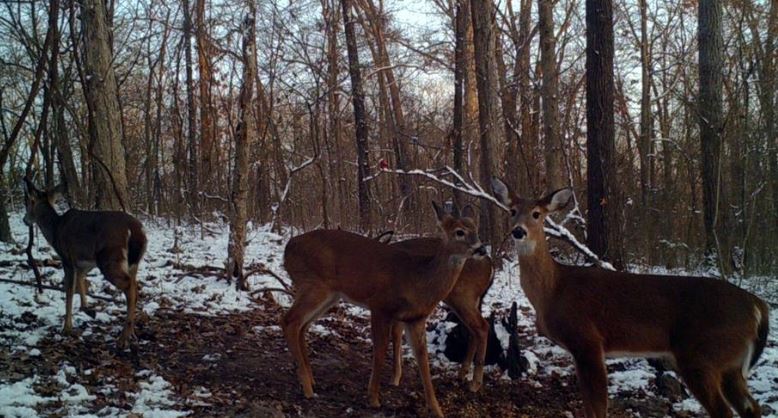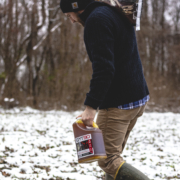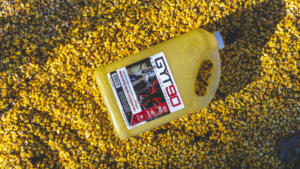Supplemental Deer Feeding | What You Need To Know
Here Are the Rules with Supplemental Deer Feeding
Depending on where you live and what you are used to, supplemental deer feeding might be common practice or an illegal offense. Many states are starting to enforce stricter limits on what can and cannot be fed to wild whitetails, primarily out of concern for spreading diseases like chronic wasting disease (CWD). But where it is legal and in the right conditions, supplemental deer feeding can be helpful. Here are some good ground rules to follow if you are considering this approach.

Nutritional Needs throughout the Year
During the course of a typical year, most whitetails change their diets pretty significantly. They do this to get the most nutrition they can during a given season. This is especially true in northern areas with harsh winters, as whitetails need to drastically switch their food sources to survive. So what do deer eat throughout the year? Here is a seasonal breakdown to show you.
Winter
As mentioned above, winter can be an especially cruel time for whitetails in northern areas, which is why supplemental deer feeding efforts are brought up so much this time of year. What do deer eat in the winter? Snow often covers all herbaceous vegetation, leaving only woody browse for them to eat. Branches are not very digestible (they are very high in fiber) and have little nutrition. But deer are adapted for this scenario, and their four-chambered stomach allows them to survive on it. In agricultural areas, they will also devour standing soybeans or corn for their high fat and carbohydrate content.
Many bucks enter winter at a deficit and will spend most of their time eating to catch up. Does and fawns are also in survival mode during this time of the year. This is why many people assume that winter deer feeding is helpful, although there is more to it than that, as you will see below.
Spring
Spring is full of fresh new growth after a long and stressful winter. Deer shift their diets to key in on tender green growth (e.g., grasses, forbs, leaves, etc.), which are generally higher in protein and minerals than older vegetation. This growth is also very palatable and digestible for deer. In areas with high habitat quality, supplemental deer feeding will not likely offer any benefit in the spring simply because the natural vegetation is so nutritious. Some good examples include clover or alfalfa fields, forbs and grasses in natural meadows, regrowth after a prescribed fire, or the tender tips of new branches. Why do deer seek this out in the spring?
Bucks are almost certainly at a significant loss from their fall weight, and need to eat a lot of very nutritious food to replenish their muscle mass and fat reserves before their bodies will invest much in antler growth. Likewise, many does are either pregnant or lactating to feed their new fawns. They too need a lot of nutrient-dense foods to fuel this cycle. Finally, last year’s fawns are also playing catch-up with body mass, and will consume a lot of food to do so.
Summer
The summer period is a time of routines for whitetails. They will seek out reliable food sources, such as agricultural crops (e.g., soybeans, corn, etc.) or young clear-cuts to feast on foods high in protein and carbohydrates. They usually do not bed too far from food, and spend each day on a simple rotation of feeding and bedding.
Again, this is a rebuilding phase for deer. Bucks are hopefully back up to their original muscle mass after a stressful winter, and they are also using nutrients and minerals to fuel antler growth. Many supplemental deer feeding efforts during the summer focus on providing high-nutrient/high-mineral content deer feed to help bucks build their antlers fast. Does are still nursing fawns and trying to maintain their own bodies during the summer. Fawns are weaning themselves and eating a lot of vegetation too.
Autumn
Fall is usually the fourth quarter for deer (and many other animals). They need to make the final push to put on as much weight as possible before winter arrives. As such, they switch from high-protein diets to food high in fat and carbohydrates, which puts as much fat on their bodies as possible. Some good fall food sources include hard mast (e.g., oak acorns, beech nuts, chestnuts, hickory nuts, etc.), soft mast (e.g., apples, pears, persimmons, etc.), and agricultural crops (corn, soybeans, brassicas, cereal grains, etc.).
While bucks will definitely eat a lot in the early part of the fall, they tend to switch out of this pattern as the rut approaches. When the rut occurs, most bucks focus their time on chasing and breeding does or fighting rival bucks. During this time, they can lose a substantial amount of their body weight. Does and fawns, on the other hand, will eat as much as possible during the fall. As long as they are not being chased or harassed by bucks, you will find them feeding throughout the day and night in many areas.
What to Feed Deer
So now it is time for the ultimate question: what is the best thing to feed deer? Sure, it sounds like they get a lot of their food naturally, but what if your area is lacking in habitat quality or good food sources? This is where well-intentioned (but misinformed) people can go wrong. Assuming supplemental deer feeding is indeed legal where you live, here are a few tips on what to feed and what not to feed deer.
First, the best deer feed will always be the same as or reminiscent of their natural food sources for a given season, plain and simple. They are naturally adapted for certain foods at specific times of the year, so why mess with what works? Like the name itself, it should be a supplement to what is already available to them. For example, it is tough to beat corn piles over the summer or in the fall for supplemental deer feeding. Many deer are already consuming a lot of corn in agricultural fields anyway and it has a high level of carbohydrates that they are seeking.
However, if you were to suddenly introduce a lot of corn to deer that are not used to eating it in the winter, you could cause acidosis. Basically, their bodies cannot process that sudden infusion of the new food and they can die as a result. So as far as what to feed deer in winter or what to feed deer instead of corn, stick to more natural sources like cutting a small patch of forest down to bring browse to deer level. This is a very inexpensive way to feed deer – all you need is a chainsaw and a couple hours of your time. And as this patch grows into young forest, it will provide more browse for deer over the winter.
If deer are already used to eating corn throughout the winter in your area, you can start feeding corn to deer slowly and see how they take it, but you will likely have no problem feeding deer corn year round in these areas. Ultimately, the best supplemental deer feed is one that the deer in your area will be attracted to that actually helps them gain body mass.

Now when it comes to feeding deer in summer or spring, you have many more options. Many people will buy high protein deer feed for their supplemental deer feeding program. This helps them bounce back and recover muscle mass faster, and for bucks, it can help with antler growth too. You could combine the deer protein pellets with our GYT90 deer attractant (4 gallon case) to make your own custom deer antler feed. The high fat crude soybean oil serves as an attractant, helps them gain weight, and provides many essential minerals for antler growth, including calcium and phosphorous. Just mix it into your feed or pour it over piles of food.
Where and How to Feed Deer
As for where and how you should go about your supplemental deer feeding, you have a few options. You should find something that works for your own situation, because a consistent feeding program is more important and useful than a haphazard one.
Food Piles
The easiest route is to simply go out and dump the deer feed into a pile somewhere. You can quickly do this along access roads and trails, which also makes for easy checking of trail cameras. But the downside to this kind of supplemental deer feeding is that the exposed food can be eaten by other animals, including crows, blue jays, squirrels, raccoons, hogs, bears, etc. Being exposed to the elements on the ground, it can also rot faster. Deer food pellets in particular tend to turn into mush when they sit on wet ground or it rains.
Feeders
A better option for most situations is to use a deer feeder. Gravity-fed or battery-powered feeders protect the deer feed ingredients from spoiling and regulate it better. Deer cannot come in and gulp it all down – they have to eat only a little at a time. Feeders are easiest to refill if they are located alongside trails too. The best time to feed deer with a feeder is usually during the day, which can train them to come during shooting hours. If you can’t hunt deer over or near feeders, the timing really doesn’t matter as much.
Other Locations
Of course, other places are good to feed deer too.

- Small openings just off large agricultural fields can be great spots because they are often staging areas for deer before venturing out into fields at night anyway.
- Small patch cuts in an otherwise mature forest will attract deer as is. When you add supplemental deer feeding or mineral sites, you can bet it will be a popular spot.
- If you find a series of deer trails that converge between feeding and bedding areas, it could be a great area for a deer feeder. It already gets a lot of deer traffic, and you should be able to get great trail camera pictures there too. Just try to use a larger feeder in these spots so you don’t have to refill too often.
Is Supplemental Deer Feeding Right for You?
If your property lacks abundant natural food sources throughout the entire year, there may be an opportunity for you to use supplemental feed to help the deer herd. And if it is not legal or relevant where you hunt, try managing the natural food sources the best you can. It will definitely make a difference.



